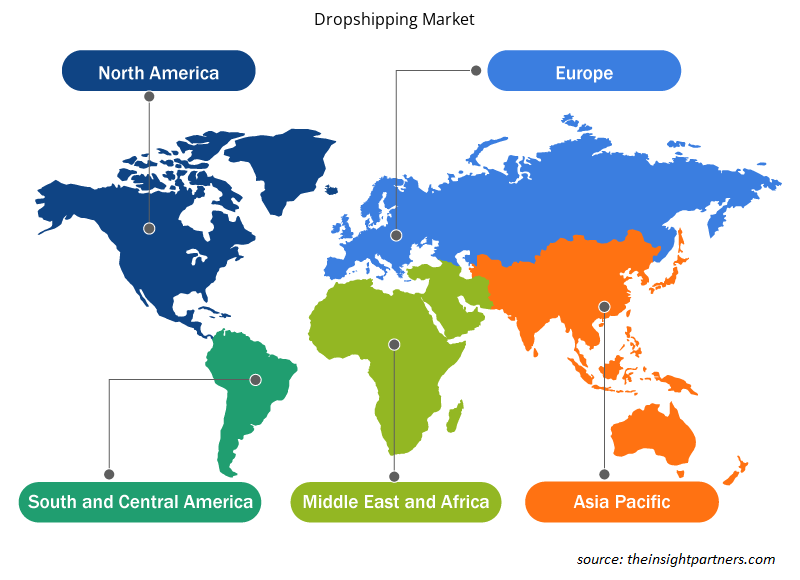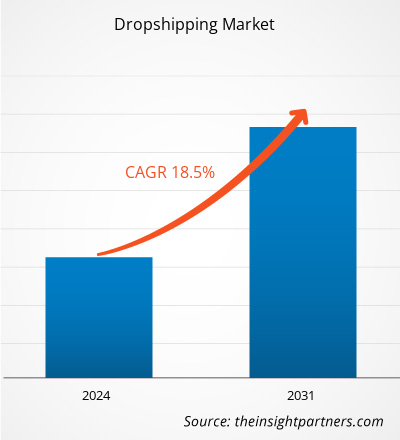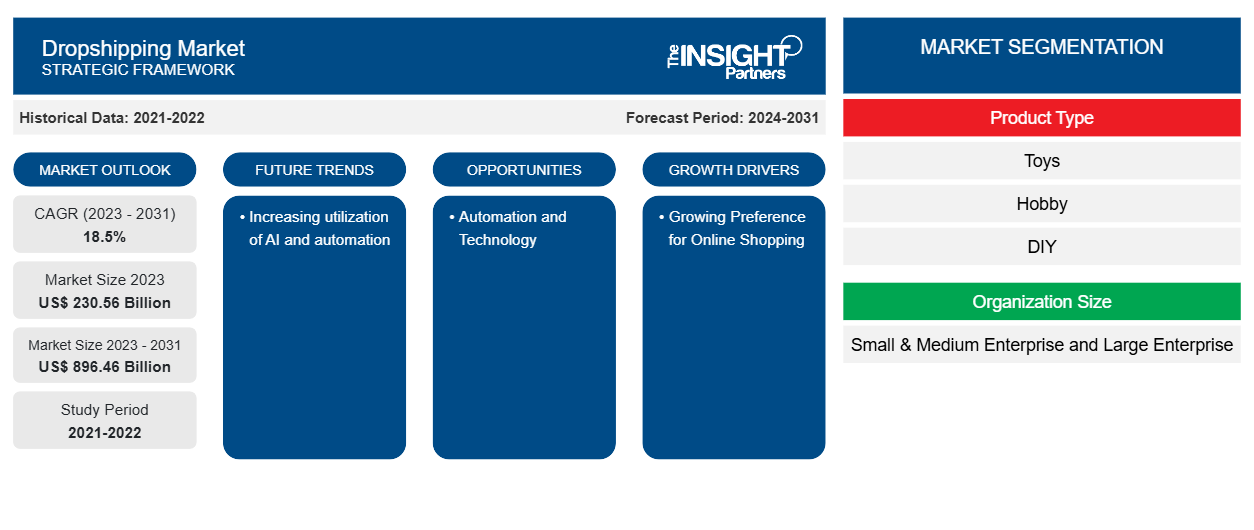Si prevede che le dimensioni del mercato globale del dropshipping cresceranno da 230,56 miliardi di dollari nel 2023 a 896,46 miliardi di dollari entro il 2031; si prevede che si espanderà a un CAGR del 18,5% dal 2023 al 2031. È probabile che l'utilizzo crescente dell'intelligenza artificiale e dell'automazione rimanga una tendenza chiave del mercato del dropshipping.
Analisi del mercato del dropshipping
Il fiorente settore dell'e-commerce ha visto un'enorme espansione negli ultimi anni, dando impulso al business del dropshipping. L'ascesa del settore dell'e-commerce ha reso più semplice per le aziende stabilire vetrine online e accedere a una base di clienti mondiale, dando impulso al mercato del dropshipping.
Panoramica del mercato del dropshipping
Il dropshipping è un approccio al dettaglio in cui un'attività online non tiene i suoi articoli in inventario. Invece, quando un consumatore effettua un ordine, l'attività lo invia insieme al pagamento a un fornitore di dropshipping. Il fornitore invia quindi la merce al consumatore . Molti titolari di attività scelgono il dropshipping perché consente ai fornitori di gestire l'evasione degli ordini. Ciò implica che i rivenditori non devono investire in spazio di stoccaggio o rischiare di rimanere intrappolati con prodotti invenduti. Di conseguenza, le aziende possono dedicare più risorse ad altre operazioni di vendita al dettaglio, incluso il marketing.
Personalizza questo report in base alle tue esigenze
Riceverai la personalizzazione gratuita di qualsiasi report, comprese parti di questo report, o analisi a livello nazionale, pacchetto dati Excel, oltre a usufruire di grandi offerte e sconti per start-up e università
-
Scopri le principali tendenze di mercato in questo rapporto.Questo campione GRATUITO includerà analisi di dati che spaziano dalle tendenze di mercato alle stime e alle previsioni.
Driver e opportunità del mercato del dropshipping
Crescente preferenza per lo shopping online per favorire il mercato
L'e-commerce sta trasformando il panorama della vendita al dettaglio. Le abitudini di acquisto delle persone stanno cambiando rapidamente e acquistare qualsiasi cosa online sta diventando il nuovo standard. Questa espansione è guidata da una serie di cause, tra cui lo sviluppo del commercio mobile, l'ascesa dei social network e la crescente popolarità dei servizi in abbonamento. I paesi dell'Asia-Pacifico e del Sud America stanno ora sperimentando lo sviluppo più rapido nel settore dell'e-commerce . Ciò è attribuibile sia al rapido adattamento delle nuove tecnologie sia alla struttura demografica di queste nazioni, che ha più giovani che anziani. Queste giovani generazioni sono più esperte di tecnologia e preferiscono fare acquisti online piuttosto che offline.
Automazione e tecnologia
Il dropshipping è una strategia aziendale in cui il venditore non detiene scorte in magazzino, ma invia gli ordini dei clienti e i dati di spedizione al produttore, a un altro commerciante o a un grossista, che distribuisce i prodotti direttamente al cliente. I drop shipper traggono grandi vantaggi dall'automazione poiché migliora la produttività e semplifica le operazioni. I drop shipper possono risparmiare tempo e ridurre al minimo il carico automatizzando molte aree della loro attività, con conseguente maggiore efficienza e redditività. Il software di automazione del dropshipping aiuta i drop shipper ad automatizzare le attività quotidiane, tra cui l'inoltro degli ordini ai produttori, la gestione dell'inventario e le procedure di spedizione. is a business strategy in which the seller does not hold inventory in stock but instead sends customer orders and shipment data to the manufacturer, another merchant, or a wholesaler, who distributes the products straight to the client. Drop shippers benefit greatly from automation since it improves productivity and streamlines operations. Drop shippers may save time and minimize burden by automating many areas of their business, resulting in a more efficient and profitable operation. Dropshipping automation software helps dropshippers automate daily duties including order routing to manufacturers, inventory management, and shipment procedures.
Analisi della segmentazione del rapporto di mercato del dropshipping Market Report Segmentation Analysis
Segmenti chiave che hanno contribuito alla derivazione dell'analisi di mercato del dropshipping: tipo di prodotto e dimensioni dell'organizzazione.
- In base al tipo di prodotto, il mercato è suddiviso in giocattoli intelligenti, hobby e fai da te, mobili ed elettrodomestici, cibo e cura della persona, elettronica e media, moda e altri. Il segmento dell'elettronica e dei media ha detenuto una quota di mercato maggiore nel 2023.
- In base alle dimensioni dell'organizzazione, il mercato è diviso in piccole e medie imprese e grandi imprese. Il segmento delle grandi imprese ha detenuto una quota di mercato maggiore nel 2023.
Analisi della quota di mercato del dropshipping per area geografica Market Share Analysis by Geography
L'ambito geografico del rapporto sul mercato del dropshipping è principalmente suddiviso in cinque regioni: Nord America, Asia Pacifico, Europa, Medio Oriente e Africa e Sud America/Sud e Centro America. Il Nord America ha dominato il mercato del dropshipping nel 2023. L'aumento del reddito disponibile dei consumatori è uno dei fattori che guidano la crescita del mercato del dropshipping in Nord America. Il dropshipping offre vantaggi come minori costi generali e un ampio portafoglio di prodotti, che attraggono i rivenditori e contribuiscono alla crescita del mercato.
Approfondimenti regionali sul mercato del dropshipping
Le tendenze regionali e i fattori che influenzano il mercato del dropshipping durante il periodo di previsione sono stati ampiamente spiegati dagli analisti di Insight Partners. Questa sezione discute anche i segmenti e la geografia del mercato del dropshipping in Nord America, Europa, Asia Pacifico, Medio Oriente e Africa e Sud e Centro America.

- Ottieni i dati specifici regionali per il mercato del dropshipping
Ambito del rapporto sul mercato del dropshipping
| Attributo del report | Dettagli |
|---|---|
| Dimensioni del mercato nel 2023 | 230,56 miliardi di dollari USA |
| Dimensioni del mercato entro il 2031 | 896,46 miliardi di dollari USA |
| CAGR globale (2023-2031) | 18,5% |
| Dati storici | 2021-2022 |
| Periodo di previsione | 2024-2031 |
| Segmenti coperti |
Per tipo di prodotto
|
| Regioni e Paesi coperti |
America del Nord
|
| Leader di mercato e profili aziendali chiave |
|
Densità degli attori del mercato: comprendere il suo impatto sulle dinamiche aziendali
Il mercato del Dropshipping sta crescendo rapidamente, spinto dalla crescente domanda degli utenti finali dovuta a fattori quali l'evoluzione delle preferenze dei consumatori, i progressi tecnologici e una maggiore consapevolezza dei vantaggi del prodotto. Con l'aumento della domanda, le aziende stanno ampliando le loro offerte, innovando per soddisfare le esigenze dei consumatori e capitalizzando sulle tendenze emergenti, il che alimenta ulteriormente la crescita del mercato.
La densità degli operatori di mercato si riferisce alla distribuzione di aziende o società che operano in un particolare mercato o settore. Indica quanti concorrenti (operatori di mercato) sono presenti in un dato spazio di mercato in relazione alle sue dimensioni o al valore di mercato totale.
Le principali aziende che operano nel mercato del Dropshipping sono:
- AliDropship
- Società per azioni Doba Inc.
- Zona di Dropshipping
- Fonte di inventario
- Megagoods, Inc.
- Modalyst, Inc.
Disclaimer : le aziende elencate sopra non sono classificate secondo un ordine particolare.

- Ottieni una panoramica dei principali attori del mercato del dropshipping
Notizie e sviluppi recenti del mercato del dropshipping
Il mercato del dropshipping viene valutato raccogliendo dati qualitativi e quantitativi dopo la ricerca primaria e secondaria, che include importanti pubblicazioni aziendali, dati associativi e database. Di seguito è riportato un elenco degli sviluppi nel mercato:
- A marzo 2023, ShipStation ha lanciato ShipStation Dropship Manager, una nuova soluzione progettata specificamente per i gestori di dropship. Questo prodotto mira ad automatizzare e semplificare i processi di evasione degli ordini, riducendo gli errori causati dalla gestione manuale dei fornitori. Le funzionalità principali di ShipStation Dropship Manager includono l'instradamento degli ordini, gli aggiornamenti in tempo reale sullo stato degli ordini tra gestori di dropship e fornitori, il monitoraggio del marchio e la possibilità di utilizzare un dominio e-mail personalizzato per un maggiore coinvolgimento dei clienti. Inoltre, i gestori di dropship possono invitare i propri fornitori a unirsi alla piattaforma, facilitando un rapido onboarding e l'ingresso nel mercato.
(Fonte: ShipStation, Comunicato stampa, 2023)
Copertura e risultati del rapporto sul mercato del dropshipping
Il rapporto "Dimensioni e previsioni del mercato del dropshipping (2021-2031)" fornisce un'analisi dettagliata del mercato che copre le seguenti aree:
- Dimensioni del mercato e previsioni a livello globale, regionale e nazionale per tutti i segmenti di mercato chiave coperti dall'ambito
- Dinamiche di mercato come fattori trainanti, vincoli e opportunità chiave
- Principali tendenze future
- Analisi dettagliata delle cinque forze PEST/Porter e SWOT
- Analisi di mercato globale e regionale che copre le principali tendenze di mercato, i principali attori, le normative e gli sviluppi recenti del mercato
- Analisi del panorama industriale e della concorrenza che copre la concentrazione del mercato, l'analisi della mappa di calore, i principali attori e gli sviluppi recenti
- Profili aziendali dettagliati
- Analisi storica (2 anni), anno base, previsione (7 anni) con CAGR
- Analisi PEST e SWOT
- Valore/volume delle dimensioni del mercato - Globale, Regionale, Nazionale
- Industria e panorama competitivo
- Set di dati Excel
Report recenti
Testimonianze
Motivo dell'acquisto
- Processo decisionale informato
- Comprensione delle dinamiche di mercato
- Analisi competitiva
- Analisi dei clienti
- Previsioni di mercato
- Mitigazione del rischio
- Pianificazione strategica
- Giustificazione degli investimenti
- Identificazione dei mercati emergenti
- Miglioramento delle strategie di marketing
- Aumento dell'efficienza operativa
- Allineamento alle tendenze normative























 Ottieni un campione gratuito per - Mercato del dropshipping
Ottieni un campione gratuito per - Mercato del dropshipping